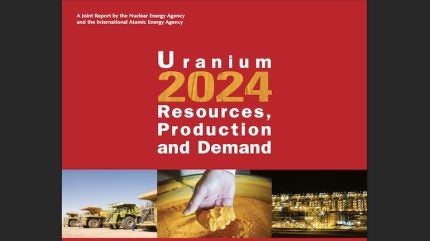
The latest edition of Uranium – Resources, Production and Demand (the Red Book) says sufficient uranium resources exist to support both the continued use of nuclear power and its significant growth through 2050 and beyond. However, timely investments in new exploration, mining operations and processing techniques will be essential to ensure that uranium becomes available to the market when needed.
The Red Book is prepared jointly every two years by the Organisation for Economic Co-operation & Development Nuclear Energy Agency (NEA) and the International Atomic Energy Agency (IAEA). The Joint NEA/IAEA Group on Uranium (UG) contributes to the preparation of each Red Book.
The 608-page 2024 edition, covering the calendar years 2021 and 2022, reviews uranium market fundamentals, based on official government data, and delivers a detailed statistical profile of the global uranium industry. It features data on uranium exploration, resources, and production and includes 62 country profiles, offering in-depth insights into mine development plans, the environmental and social dimensions of uranium mining, and national regulations and policies.
The Red Book indicates that global identified recoverable uranium resources amounted to 7,934,500 tonnes as of 1 January 2023. These represent all reasonably assured and inferred uranium resources that could be recovered at market prices ranging from $40-260 $/KgU (equivalent to $15-100 $/lb U3O8). This represents an increase of less than 0.5% compared with figures in the 2022 edition. Additions to the uranium resource base could however arise from undiscovered or unconventional sources, driven by the sharp rise in uranium spot prices since mid-2021 and the commitment first announced during COP28 and now signed by 31 countries to triple their nuclear energy capacity by 2050.
Worldwide domestic exploration and mine development expenditures have increased dramatically after a period of decline due to poor market conditions and the COVID-19 pandemic. Annual expenditures reached $800m in 2022 and preliminary data for 2023 suggest a further increase to $840m.
The Red Book also provides projections for nuclear power installed capacity and uranium requirements through to 2050, outlining both low-growth and high-growth scenarios, alongside an assessment of uranium supply and demand adequacy under each scenario.
Production increased 4% between 2020 and 2022 and the report suggests the increase should continue in coming years. The establishment of new production centres is anticipated to encounter significant lead times due to today’s risk-averse investment climate, and complex and lengthy regulatory processes in many uranium mining jurisdictions. Geopolitical challenges and technical difficulties related to developing new mines and milling facilities may further compound the situation. “As a result, efforts must begin immediately to ensure adequate uranium supplies are available in the medium term, the Red Book says.
To bring in-ground resources into production, market conditions must offer confidence in project returns. Poor market conditions delay not only new supply but also exploration investments, which impacts long-term resource development. For sustained uranium supply, both consumers and producers must ensure a stable framework for uranium exploration, mining, and transportation, supported by pricing mechanisms that encourage long-term investments. Sustained, adequate uranium prices are essential to support both new projects and ongoing exploration, as global uranium demand could more than double by 2050 in a high demand scenario and increase by 45% in a low-demand case.
Following a decade-long downturn, the uranium market began to recover in 2021, with prices rising from $30/lb U3O8 at the start of 2021 to a high of $106/lb U3O8 in January 2024. In response, exploration and mine development activities have increased, with some previously stalled projects nearing final investment decisions. About half of previously idled production capacity has returned to production, although remaining capacity may require higher prices to restart.
Increasing global momentum for nuclear energy, driven by climate goals and commitments such as the call by over 20 countries to triple global nuclear energy by 2050 announced at (COP28, suggests a positive outlook for uranium demand, particularly as small modular reactors (SMRs) gain traction. In the longer term, advanced reactor designs and closed fuel cycles with recycling capabilities, if successfully developed, may have the potential to exploit existing uranium resources for at least several centuries, ensuring the long-term sustainability of nuclear energy.
Additionally, unconventional uranium sources, such as phosphate deposits and black shales, could further extend uranium availability, particularly with the emergence of new technologies. “Given the long lead times for project development, identifying and advancing new projects in the near to medium term is crucial to avoid potential supply disruptions. Sustained adequate uranium prices will be required to drive new production, support exploration to replace depleting resources, and justify investment in innovative extraction techniques for unconventional uranium sources.”






